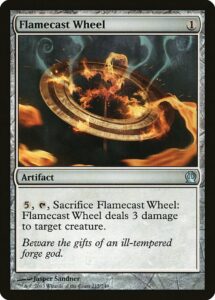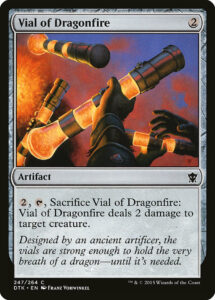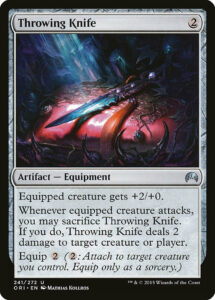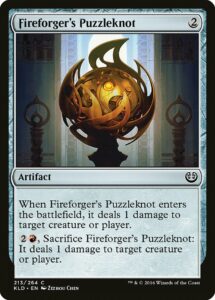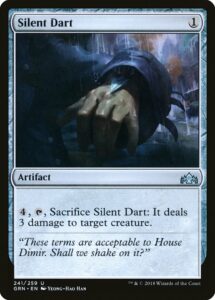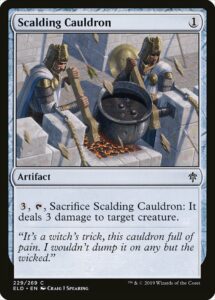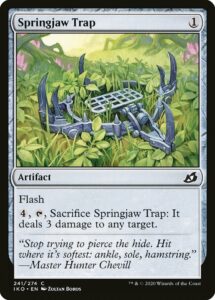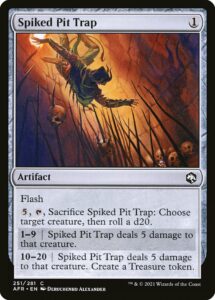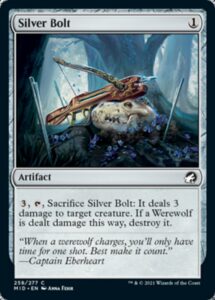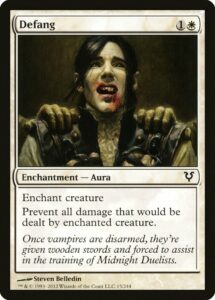Colorless removal is underpowered by design. Because it can be used by any deck, it can’t be allowed to outperform the colors that specialize in any particular effect. It can provide colors access to effects they wouldn’t normally have access to—Universal Solvent and Scour from Existence provide an effect no one color is supposed to have—but always at a premium.
But Magic is always changing. As colored creatures and removal spells have gotten both stronger and cheaper over time, colorless effects have followed the trend. In fact, this trend is apparent just over the past decade. So while I’d be happy to talk about Aeolipile and how it took over twenty years to start seeing comparably potent artifacts which sacrifice to do damage, we’ll instead start a mere twelve years ago with the first Zendikar and its contribution.
Blazing Torch is one of the most aggressively costed colorless Shocks in Magic. Of course, the price tag came with a catch: it required both a creature to throw the torch and taking a turn off of attacking in highly aggressive Zendikar.
The design is fabulous. The visual of scaring off a zombie with fire or throwing a torch is clear and powerful. The bit of trinket text to make it harder for black (the best color in Zendikar draft) to block was relevant, though slightly awkward when this design was rightfully reprinted in original Innistrad—turns out, Innistrad wolves are afraid of silver, not fire. But we’re getting ahead of ourselves.
Remember this card, for it is the nadir of artifact-based removal. Flamecast Wheel came out just as I was taking Magic very seriously. It’s when Team Draft League began and I’d play at Twenty Sided Store throughout the week, traveling to both Grand Prix and PTQs every now and then. When I think of artifact removal, I can’t help but think of just how underpowered and unplayable this was, how hopelessly expensive it was to activate for my opponents who thought they were getting a good deal.
While there’s an important place for exceptionally weak cards, it’s probably for the best that we don’t see cards quite this bad anymore try to perform a Limited essential function.
2015’s Vial of Dragonfire and 2016’s Explosive Apparatus both speak to the importance of synergy. While neither is particularly efficient or powerful, each uses other components to become more than a low quality removal spell. Vial of Dragonfire paired with Renowned Weaponsmith to create an aspirational combination—it still wasn’t very strong, but they would be much deadlier when they returned in M20. Explosive Apparatus was both subtler and more flexible in its potency—because of Delirium, players actively wanted an artifact in their graveyard, so having one that did so on command made it a bit more alluring.
It turns out that throwing a torch is much easier than throwing a knife. Torches, anyone can throw at any time, but a knife needs momentum behind it.
I joke, but this execution is a lot cleaner than letting a creature hold a 0 mana Shock that everyone needs to play around (or worse, letting Moonglove Extract just sit around and make combat hard). Sure, it’s a weaker card that both Blazing Torch and Bonesplitter, but combining two effects should come at a mana or efficiency cost (and Bonesplitter is too strong for Limited, anyway).
Fireforger’s Puzzleknot was among the least impressive of its cycle. It lacked the Standard pedigree of Woodweaver’s Puzzleknot and struggled to kill relevant creatures in a Limited format with Thriving Rhino and Renegade Freighter. It’s a good reminder of something we’ll come back for today’s feature card: context. In the right format, Fireforger’s Puzzleknot would be a deadly two-for-one—imagine having access to this in original Zendikar, where there was no such thing as having too many 2/1s for 2. Alas, in Kaladesh, Shock simply couldn’t deal with enough creatures.
In 2018, things took a bit of a leap. After years of Shocks, Guilds of Ravnica introduced a Lightning Bolt that was almost, barely playable. It still wasn’t quite good enough to compete with the upgraded common creatures of today, but it paved the way for perhaps the biggest innovation of the current era.
That’s right, our giant innovation is the simplest card we’ll see today. It’s Silent Dart but a mana cheaper to activate and downshifted to common. This didn’t break Throne of Eldraine Limited, but it was playable. It almost always traded down on mana, but it was a viable tool for decks light on removal and gave players something to do with the mana they’d usually waste on turn one. Having a colorless removal spell was especially important in Throne of Eldraine Limited, where players needed artifacts to help them play monocolor decks.
Within six months, Ikoria would introduce a twist on Scalding Cauldron. For one mana more, you could surprise your opponent and also hit players and planeswalkers. Unless you were using Lurrus of the Dream Den, that wasn’t a good trade. Creatures in Ikoria were either too big for this kill or too cheap for the exchange to be profitable. It’s an important reminder of how important mana efficiency is. Three mana is a lot, but four mana requires dedicating an entire turn—it’s just too punishing to hold up four mana and not use it.
A year later, Adventures in the Forgotten Realms looked at Springjaw Trap and thought, “let’s go bigger.” In most formats, this is a six mana kill spell—playable, but not amazing. In AFR, where treasure made mana easier to come by and scant synergy made it so creatures usually weren’t more than the sum of their parts, this was a fairly decent removal spell. Not something you’d prioritize, but something you’d be fine with playing a copy of. Which is sort of exactly how good colorless removal spells should be. The added upside of a 55% chance of recouping a bit of your mana investment was icing on the cake and is a reminder that are still so many untapped ways of letting cards generate fractional value.
Finally, we reach today and our feature card. Silver Bolt looks quite similar to Scalding Cauldron. Obviously, it should—they’re the same card, except differently named and with the spot-on flavor of killing werewolves dead. Both are acceptable but replaceable removal spells—you’re happy playing one and less happy playing several. But context is key. In Throne of Eldraine, the inclusion of an expensive Lightning Bolt didn’t do much to disrupt decks like monowhite aggro, monored aggro, or monogreen midrange that could go under or over it. In Innistrad: Midnight Hunt, the story is a little bit different.
There are a lot of good cheap creatures in MID. Part of this is due to every color needing to have cheap creatures so that they don’t get run over by werewolves, but some of the best creatures in the format, like Siege Zombie and Skaab Wrangler, die to Silver Bolt. It can break up Covens. Because it’s so inexpensive, it can flip Night to Day. It’s got plenty more utility than Scalding Cauldron by virtue of the Midnight Hunt’s mechanics and creature size, and then we get to the silver lining and the problem.
It makes total flavor sense for Silver Bolt to kill werewolves. It makes total sense to include it as a failsafe in a set filled with werewolves. It makes total sense to follow Spiked Pit Trap‘s example and squeeze in some bonus fractional value. The problem is that werewolves are Midnight Hunt’s marquee creature type. Giving every deck a maindeckable answer to every werewolf damages an archetype that players probably expected would feature more prominently than the weakest color pair in Limited.
Of course, Silver Bolt doesn’t do that damage alone—black has three powerful common removal spells that deal with every werewolf, Daybound makes it so there can’t be common one and two mana werewolves, and the common werewolves aren’t especially pushed. But Silver Bolt is perhaps the best example we have of colorless removal going just a bit too far. If it were just Scalding Cauldron, it’d still be good enough to play. If it were a Springjaw Trap that was Doom Blade for werewolves, that would probably also be fine. But tacking on fractional value that hoses an entire archetype should come at more of a cost than zero mana, especially if that archetype isn’t strong enough in the first place.
One of the many joys of Magic’s rich history is using its past to guess at the future. Perhaps Silver Bolt could lead to a sudden drop off in power level of common colorless removal. Perhaps we’ll continue to see Scalding Cauldrons and Spiked Pit Traps with upside—a lot of people play Best of One and they need colorless removal spells. There’s an enormous difference in dealing 3 damage for 2 mana (which makes combat too difficult), 3 (which feels like the sweet spot, but has little room for anything else), and 4 mana (which needs a real bonus to justify itself). It’ll be exciting seeing which directions Wizards goes with its next five designs. Because every card, no matter how unassuming or underpowered, draws from a rich history and tells a complete, intricate story.
Zachary Barash is a New York City-based game designer and the commissioner of Team Draft League. He designs for Kingdom Death: Monster, has a Game Design MFA from the NYU Game Center, and does freelance game design. When the stars align, he streams Magic (but the stars align way less often than he’d like).



